Maintaining Your Pop Up Camper Battery
The life of your deep cycle battery will be greatly affected by the way you use and maintain it. How the battery is used, how deeply it is discharged, how it is recharged, temperature, and how it is stored are all things that factor into a battery’s life span. I’ve read in many forums that you can expect to get 4-8 years from a deep cycle battery, but when we purchased the battery at Costco, we were told we’d be lucky to get 2 years from our battery. We’re hoping to prove them wrong by following these guidelines:
Charging Your Battery
Remember, we said deep cycle batteries were meant to be deeply discharged and recharged over a long period of time, but sitting for extended periods of time in a partially discharged state is hard on deep cycle batteries. Part of the problem with our battery was that we were deeply discharging it, but we weren’t recharging it fully or in a timely manner. The life cycle of a battery depends heavily on how soon it is recharged. The sooner the better. We were aware that we needed to recharge our battery after our trips, but we thought our camper’s converter/charger was doing that job for us while we were plugged into shore power or driving to our next destination. While it’s true that your camper’s converter will charge your battery, it isn’t the most effective method. Most older campers aren’t equipped with a converter than can properly charge your battery. For proper battery charging and maintenance, you’ll need a 3-stage charger like the one we purchased. It’s a BatteryMINDer 2012, and we were very impressed with how easy it was to charge and check our new battery.
Proper battery charging takes place in three basic stages: bulk, absorption, and float. Bulk charge is the first stage of charging and is when about 80-90% of your battery capacity is replaced. Once that is reached, the absorption stage begins. Here the voltage remains constant, but the current tapers until the battery is about 98% charged. Then we move on to our float charge. After batteries reach full charge, charging voltage is reduced to a lower level to prolong battery life. The main purpose is to keep an already charged battery from discharging, so you’ll often hear this stage referred to as maintenance or trickle charging as well. This stage is important, because if your camper charger isn’t designed to provide a proper float charge and the voltage is too high, it will begin to boil off the battery’s electrolyte level. There are a lot of fantastic websites that go into greater detail on battery charging and care, if you want to read more in depth information. One of my favorite sites is this one.
Don’t assume that just because you bought a new battery, it is topped off and ready to go. When we hooked up our new battery to our BatteryMINDer, I was shocked to see that the charger went straight to the bulk stage. Mr. TypeTwoFun reminded me that we had no idea how long the battery had been sitting on the Costco shelves. After a few hours, though, our battery was topped off and sitting in the float stage. Another great thing about this charger is that it also desulfates the battery. Sulfation is a build up of lead sulfate crystals within the battery and is a major cause of battery failure. All batteries will develop sulfation over time, but they will develop sulfation more rapidly if they are overcharged, undercharged, or left discharged for long periods of time. A desulfating battery charger uses high frequency electronic pulses to dissolve sulfation crystals, and thus extend the life of your battery. If battery life is important to you, I’d suggest looking for a charger with a desulfation mode.
Once you’ve got your battery all charged up, you can either choose to leave it hooked up to your charger in float mode until you are ready to use it, or you can check and charge it periodically (at least once a month) to make sure it is charged and maintained. We chose to leave it hooked up, so it would be ready when we needed it. I just know I’ll forget to check and charge it monthly. Now I just have to remember to put it in the camper before we leave! 😉
Testing Your Battery
Of course, you should visually inspect your battery frequently for corroded terminals or cables, low electrolyte fluid, and damaged cases, but you should also test your battery’s voltage. Even if you keep your battery on the charger when not in use, it is still important to periodically test your battery. It will indicate if there is a problem with your battery–and you don’t want to find that out when you’re boondocking. Trust me on that one!
Before you test your battery, you’ll want to make sure there is no “surface charge” that will cause an inaccurate reading. If you’ve been charging your battery, you’ll want to disconnect the battery from the charger and let it sit for six hours with no load or charger connected. There are other ways to remove the surface charge if you’re pressed for time, but we find that this is the easiest method. If you’d like to know about other methods, you can check out this article. There is lots of great information in there.
There are two ways to test your battery. The first method uses a digital voltmeter, much like the one we installed in our camper. If you have a maintenance-free battery, this is your only testing method. Compare the reading you get on your voltmeter with the chart below to determine the state of charge of your battery.
The best way to check the state of charge of your flooded cell battery is by using a hydrometer to check the specific gravity in each cell. A hydrometer can be purchased fairly inexpensively at any auto parts store or online through Amazon. This is a great way to tell if you have a dead or weak cell in your battery. If there is a .050 or more difference in the specific gravity reading between the highest and lowest cell, you have a weak or dead cell(s).
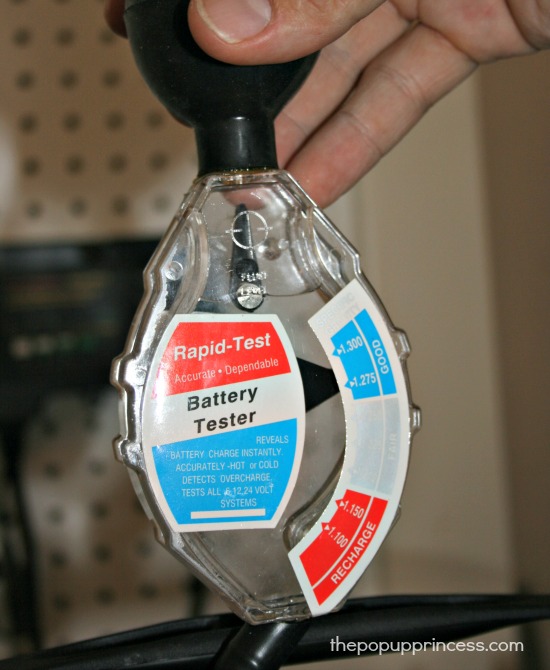 If you’ve got a weak or dead cell, or if your battery won’t recharge to a 75% or more state of charge, chances are it’s time to replace the battery.
If you’ve got a weak or dead cell, or if your battery won’t recharge to a 75% or more state of charge, chances are it’s time to replace the battery.
Care and Storage of Your Battery
If you purchased a flooded cell lead acid battery, like we did, it requires a little maintenance. You’ve got to keep an eye on the electrolyte levels of your battery and keep the levels above the plates inside the battery at all times. Electrolyte is lost whenever the batteries are deeply discharged or recharged. Once a month you should check the electrolyte levels of your battery–and more frequently during the hot summer months. To replenish the battery electrolyte, simply add distilled water as necessary. Don’t overfill. The electrolyte simply needs to cover the plates. Never add acid or tap water, as the chemicals in tap water can kill your battery early.
Caution: Batteries contain sulfuric acid, which is highly corrosive. Make sure you wear the appropriate protective gear and goggles when checking the electrolyte levels and testing the specific gravity of your battery cells. In case of a spill, immediately flush the area with plenty of cold water to dilute the acid.
Batteries that sit in your camper for extended periods without use will self-discharge over time. You have things like your CO2 monitor that are always on and will drain the battery slowly over time as well. Deep discharges reduce the life of your battery, and a partially charged battery is also prone to freezing in extremely cold temperatures. Freezing will kill a flooded cell battery. It’s a good idea to store your battery in a warmer area, like the garage, during those winter months. Remember to stay on top of charging and maintenance, and your battery will be ready to go come springtime.
I think that about covers the basics. There is so much more information to learn about batteries and maintenance, but if you want to hear it from the professionals, I highly recommend these websites. They were instrumental in helping us figure out just what we’d done wrong. Did you already know all the ins and outs of battery maintenance? Have any helpful tips or tricks to add? Sound off in the comments below! I’d love to hear from you! 😀
Happy Camping!
Disclaimer: This post contains Amazon affiliate links. The Pop Up Princess is a participant in the Amazon Services LLC Associates Program, an affiliate advertising program designed to provide a means for sites to earn advertising fees by advertising and linking to Amazon.com. This means that if you choose to purchase an item from a link in this post, The Pop Up Princess earns a small advertising fee to help pay for future projects and posts… so thank you! 🙂
Happy Camping!







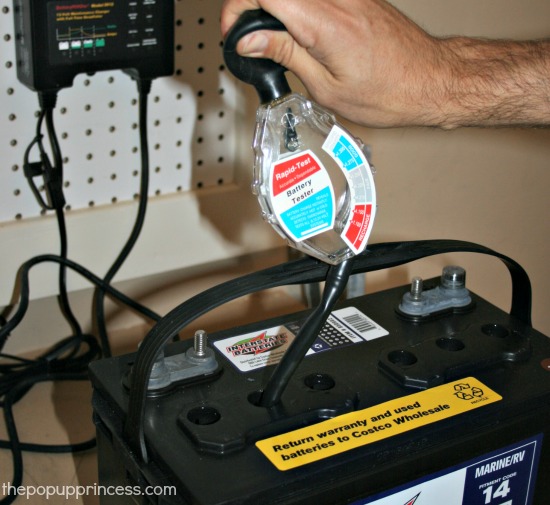
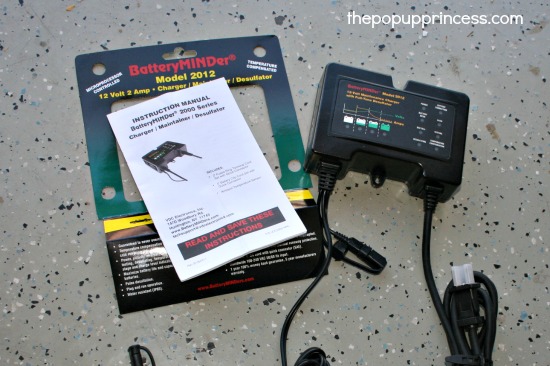
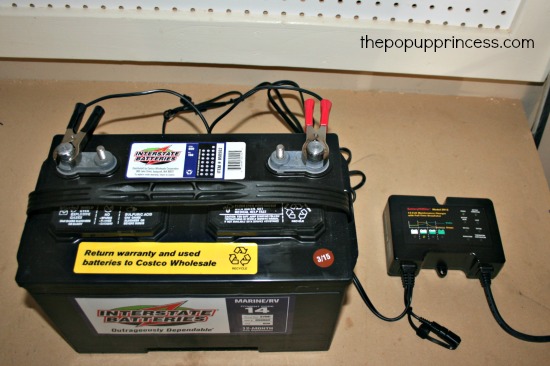


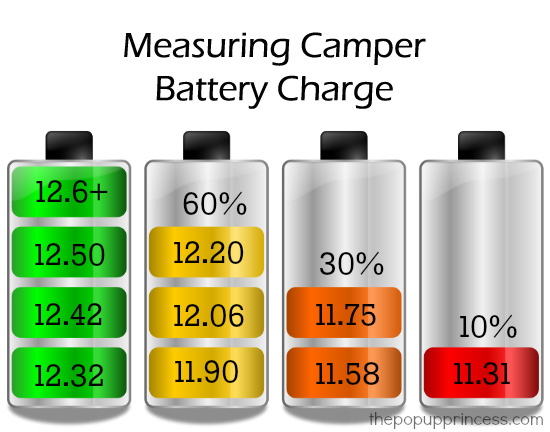

My family just picked up our first pop up yesterday and in doing various research came across your site. What an amazing job you are doing and it’s great that you explain everything in lay person’s terms. I do have to pick up a new battery so your blog on battery maintenance was very helpful. I can see one of my first projects being the voltmeter. My question is, do you or your readers have any thoughts on a solar panel for charging the battery while at primitive sites? I thought if we camped at a primitive site for several days or longer this might be a great way to recharge the battery. Some of the sites discussing solar for RV’s I have been to are older and some are frankly making my head spin. I’m just not sure of all the gotchas to look for. Thanks in advance for any advice.
Congrats on the new camper, Bob! They are so much fun. We are looking at solar for our pop up camper, but I’m still in the research stages. 😉 You’re right, there are so many things to learn. It makes my head spin a bit, too. It’s definitely on our long list up camper projects, though.
Have you added solar to your camper yet? If so what did you go with?
Not yet, Robert. We definitely have it on the list, but haven’t had a chance to do much camping lately. 🙁
Really helpful article. Thank you for sharing. I have 2006 Fleetwood Utah CP, nearly brand new… Used only 7 times in 9 years. We experienced the battery problem in very 2nd trip.
Batteries were a little confusing for me, too, Ajay. Since purchasing the BatteryMINDer, we haven’t had any issues. 🙂
I have a question….When you say that the battery was charging while you guys were driving, how was it doing this? Did you guys make a connection from your vehicle (vehicles alternator?) to the camper/battery? Otherwise, great article! I just had some confusion on that because I’d also like to learn how to charge my camper battery while I’m driving and not around a electrical outlet. Thanks for any advice! BTW…GREAT WEBSITE!!!
Matt, on most 7-pin connectors there is a 12V line from your tow vehicle to your camper battery. This will charge the battery at a moderate rate while you drive, but we’ve found that if we are staying in one place for more than a night, we need a long drive to keep our battery topped off.
Now you need to explore adding solar to your camper… you’ll never go back! We can charge electronics, run the water pump, fan, lights etc every day with no hookups, no generator. Love it.
That’s next on the list, Anthony! 😀
Anthony:
Just wondering if you would care to share what type of system you are using here to help ease the learning curve.
Thanks!
My husband tell me that we need to take the battery off the trailer and charge it on a charger in our storage room. Do you know if that is a good idea or not?
That’s what we do when we charge our battery. Make sure you get a good quality charger that will also desulfate the battery. Like this one. 🙂
Hi Larissa,
One more thing to consider is the Carbon Monoxide Detector that is installed in every Pop-Up Camper. The Carbon Monoxide Detector will drain your battery if your battery is left connected to the Pop-Up. It will only take about a week to 2 weeks to drain the battery. Even if you flip the breakers on the power converter the Carbon Monoxide Detector will still stay on, it is a fail safe. The battery should be disconnected from the Pop-Up when not in use. I connect my battery the morning of the trip and I know it is ready once I get to the camp site.
I could not figure out for the life of me what was draining my battery after every camping trip until I figured out it was the Carbon Monoxide Detector.
Happy Camping!
Adam
Yep! You’re right, Adam. You’ll usually hear a beeping sound from the carbon monoxide detector when the battery is low. We typically pull the battery out of the camper and store it on the charger when not in use.
do you take it of between EVERY trip? or just for the winter? we bought our new(used) pop up in October, i was told to take it off and keep it on a trickle charger over the winter and bad me, i didnt. it was already a 5 year old battery anyway, but i killed it. ill learn next time. im reading to determine what battery to replace with and how to get the most life and use out of it. we mainly use electrical hook up when we camp but i would love to try some off grid. so back to my original question, how often do you put it on the charger? do you ever just plug in the camper and allow that to charge it?
We plug it into the trickle charger at least once a month. We have hot AZ summers, so sometimes more often. Our camper is old and doesn’t do a good job of charging it.
Hi Larissa,
You can also conserve battery life by switching your T10 Incandescent Light Bulbs to LED. The traditional incandescent bulbs draw about 1.25 to 1.35 amps per bulb x 4 bulbs in my Pop-Up and it was 5.4 amps for just 4 light bulbs which is INSANE!. I switched to LED ($6.99 for eight bulbs) and only use 0.40 amps now for all 4 bulbs, yeah that is it! I also installed AA battery Push Stick Up LED lights next to my hard wired lights to also conserve 12v battery life.
Adam
Absolutely, Adam. We covered LED lighting here, when we changed out our fixtures. Of course, you don’t have to change out the whole fixture. You can just change out the bulbs. Makes a huge difference either way. 🙂
Quick question about the outlets (1982 Starcraft Starlite). I’ve installed an LED rope around the inside of the roof.
It seems that none of the outlets work when the battery is providing the power. They all work when the pop-up is plugged in.
Any ideas?
You can’t run the outlets off your battery, Layne. They’ll only work when you are plugged into shore power. 😉
First time camping with pop up and noticed solar panels. I would like to research them. Website ideas? Or info?
That one is still on our to-do list, Tracy. We are leaning towards portable solar panels rather than mounting them to the roof of the PUP, though. 🙂
Just a comment about the CO detector draining the battery. Have you thought about removing it and capping off the wires. Replace it with a battery operated (no connections) detector. I know these are available at Home Depot and Lowes.
What about the refrigerator? I don’t think there’s an on/off switch.
You should have an on/off switch on the outside of the camper, just behind the fridge panel door. 🙂
http://www.zampsolar.com/
portable rv units.
this is what i purchased. it folds down to a suitcase size, & the plug in connection made it girl-easy to use.
i say yes invest.
We are actually considering the Renogy version of that kit, Kat. Great minds think alike. 😉
Have several Renogy systems and highly recommend them.
RV, Sea Can, Farm, Ham Go-Kit
Just clicked on the link to battery minder on Amazon from your link and ordered it. I was on the fence about whether to get this or battery tender but you sold me because I know you do your research. Thanks!
Hello,
You seem to offer some great advice so thanks for that. I had to lookup boondocking as it seems to be a well used ‘US’ term but had not made it to me here in Canada before.
We bought a larger battery that we had before purely by accident as Costco would not allow us to take out other battery into the store to do a comparison but they said bring it it with the receipt for the new one to get money back so there was a bit of back and forth in the costco parking lot and when we got home the new battery did not fit the battery box, our camping budget is so tight we cant go get another battery box so I have the camper hooked up to the house to charge the battery before we leave and I will unhook and hookup again when we arrive for the 4 day camp in a local ground.
I read a few forums and one person said idling a vehicle for 1 hour with jumpers will charge the battery at the camp ground but I am unsure how other campers will like that as idling is not very green and is banned in some areas.
We are so green that we dont even know how to charge the battery when driving, Do we need the 12v on in the tent trailer, do we leave it all off? Not even sure if having the tent trailer hooked up to the house requires us to have the 120v on to charge or if it will with it off. I feel so out of my depth. Before we got the new battery we had been camping a few times where we had to jumper the battery to get the power winch to go up and down and then just camped with LED lights from the dollar store in thee camper. We like roughing it so its okay but would prefer to have all the stuff working and understand it better.
Thanks
Robert and Michelle
Thanks so much for this! We are going through this right now! Such a headache! We actually had to hand crank it down yesterday because our brand new battery was dead!
Ugh. We had that a lot in the beginning. Now our BatteryMINDer keeps everything in working order. Just hook it up once a month or so.
Just bought a 50Watt portable solar panel for our pup (rockwood 2514g) for this camping season. Haven’t tried it yet but will let you know how it works out. Got it on sale at Canadian Tire for $100, reg price $300! So if it keeps our battery charged while boondocking for 5 days it’ll be great deal. Lots of great info on your blog. Thanks